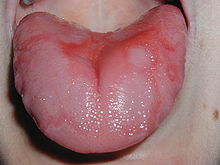Geographic tongue
This article needs additional citations for verification. (February 2008) |
| Geographic tongue | |
|---|---|
| Specialty | Oral medicine |
Geographic tongue, an inflammatory condition of the tongue affecting approximately 2% of the population,[1] is characterized by discolored regions of taste buds or sometimes even cracks in the surface of the tongue. The condition is usually chronic, and frequently manifests after eating any of a range of exacerbating foods, or during times of stress, illness, or hormonal surges (particularly in women just before menstruating). It is also known as benign migratory glossitis, oral erythema migrans, glossitis areata exfoliativa, glossitis areata migrans, lingua geographica, stomatitis areata migrans, and transitory benign plaques of the tongue.[2]: 800 [3]
Symptoms
The top side of the tongue is covered in small protrusions called papillae. In a tongue affected by geographic tongue, red patches on the surface of the tongue are bordered by grayish white. The papillae are missing from the reddish areas and overcrowded in the grayish white borders. Whitish/yellow discoloration of the tongue is frequently due to a yeast infection. The small patches may disappear and reappear in a short period of time (hours or days), and change in shape or size. While it is not common for the condition to cause pain, it may cause a burning or stinging sensation, especially after contact with certain foods. Foods that sometimes cause irritation, burning or slight swelling of the tongue include tomato, eggplant, walnuts, sharp cheeses, spicy foods, sour foods, mint, candy and citrus. Geographic tongue may also cause numbness. Coexistence of fissures of the tongue is often noticed. Chemicals, such as mouth washes and teeth whiteners, can also aggravate the condition. Lesions may occasionally occur on sites other than the tongue in the condition areata migrans.[1]
Ectopic geographic tongue
Aside from occurring on the dorsal and lateral tongue, lesions infrequently involve the ventral tongue and buccal or labial mucosa. They are rarely reported on the soft palate and flour of the mouth. This condition is called migratory stomatitis or ectopic geographic tongue.[4]
Histopathology

Irregular areas of dekeratinized and desquamated filiform papillae (red in color) are surrounded by elevated whitish or yellow margins due to acantholysis and hyperkeratosis. Neutrophils migrate into the epithelial layer, creating what are termed Munro's abscesses.
Cause
Its cause is uncertain, though it tends to run in families and is associated with several different genes, though studies show family association may also be caused by similar diets. Geographic tongue is more commonly found in people who are affected by environmental sensitivity, such as allergies, eczema, and asthma. Some think that it may be linked to stress or diets high in sugar or processed foods.[citation needed] Its prevalence also varies by nationality (0.6% of Americans, 4% of young Iraqis, 2% of young Finns) and gender (females are affected three times more than males). Causes vary, but may include zinc or vitamin B deficiencies, allergies, and hormonal changes. Geographic tongue is said to occur more often in women, especially during high hormonal times, such as during ovulation or pregnancy, and while taking birth control (generally around the 17th day).[5]
Studies show there is a link between geographic tongue and psoriasis.[6][7]
Treatment
While there is no known cure or commonly prescribed treatment for geographic tongue, there are several ways to suppress the condition, including avoiding foods that exacerbate the problem. Some individuals report relief from chewing mint leaves or sucking on a mint candy or gum during a flareup. Some people in the UK who have sensitivity to certain fruits, e.g., strawberries, tomatoes, pineapple etc., have been prescribed zinc supplements by health professionals, which has resulted in a dramatic reduction in the incidence of the condition. Some people affected by geographic tongue also report that taking vitamin B supplements causes the condition to go away temporarily. Steroid ointment may be applied topically for symptomatic patients.[1] Triamcinolone Acetonide Dental Paste USP,0.1% can be applied to affected area at bedtime, and symptoms will cease by morning. Burning may also be reduced by taking antihistamines. The condition is usually asymptomatic and insignificant; persistent pain is rare. For some sufferers, Zinc lozenges (e.g., Zincum Gluconium 2x, 13.3 mg) can be used. Marked improvement should be evident after two days, relatively normal health in four days of treatment.
See also
References
- ^ a b c Ship, Jonathan A.; Joan Phelan, and A. Ross Kerr (2003). "Chapter 112: Biology and Pathology of the Oral Mucosa". In Freedberg; et al. (eds.). Fitzpatrick's Dermatology in General Medicine (6th ed.). McGraw-Hill. p. 1208. ISBN 0-07-138067-1.
- ^ James, William D.; Berger, Timothy G.; et al. (2006). Andrews' Diseases of the Skin: Clinical Dermatology. Saunders Elsevier. ISBN 0-7216-2921-0.
{{cite book}}: Explicit use of et al. in:|author=(help)CS1 maint: multiple names: authors list (link) - ^ Rapini, Ronald P.; Bolognia, Jean L.; Jorizzo, Joseph L. (2007). Dermatology: 2-Volume Set. St. Louis: Mosby. ISBN 1-4160-2999-0.
{{cite book}}: CS1 maint: multiple names: authors list (link) - ^ Zadik Y, Drucker S, Pallmon S (2011). "Migratory stomatitis (ectopic geographic tongue) on the floor of the mouth" (PDF). J Am Acad Dermatol. 65 (2): 459–60. doi:10.1016/j.jaad.2010.04.016. PMID 21763590.
{{cite journal}}: Unknown parameter|month=ignored (help)CS1 maint: multiple names: authors list (link) - ^ GeographicTongue.org. "What is it?". Geographic Tongue. Retrieved 2011-01-17.
- ^ USA (2010-12-08). "Geographic tongue (migrant glossitis) and psoriasis". PMID 11535977.
{{cite journal}}: Cite journal requires|journal=(help) - ^ Migratory Glossitis (Geographic Tongue).
- [Shulman JD. Prevalence of oral mucosal lesions in children and youths in the USA. Int J Paediatr Dent. Mar 2005;15(2):89-97.]
- [Kleinman DV, Swango PA, Pindborg JJ. Epidemiology of oral mucosal lesions in United States schoolchildren: 1986-87. Community Dent Oral Epidemiol. Aug 1994;22(4):243-53.]
